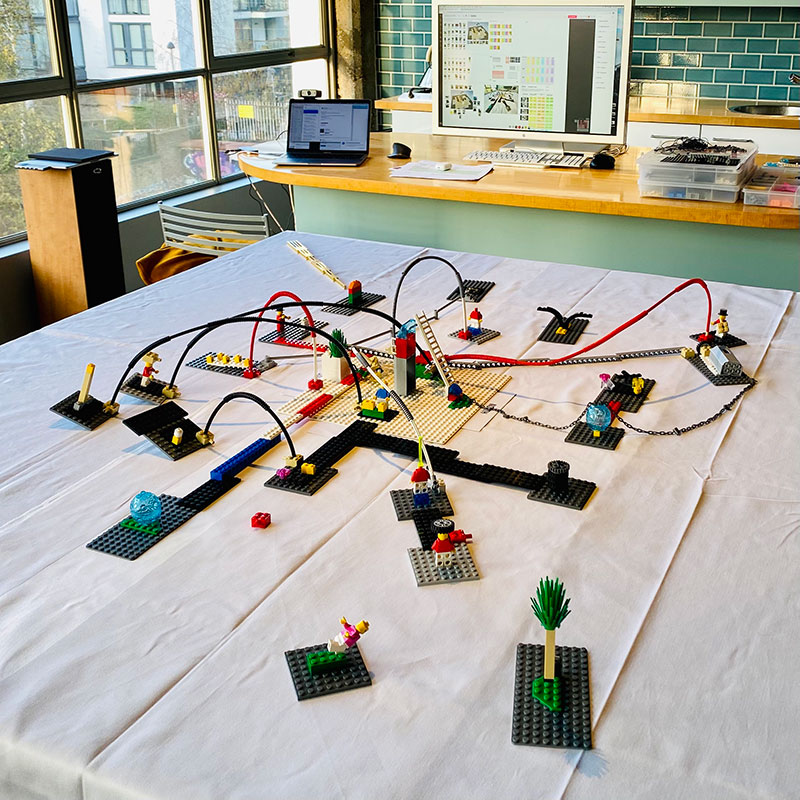



We love designing and testing ideas before we launch new techniques or trainings. The idea of prototyping is second nature to design trained SeriousWork founder Sean Blair.
In March 2021 we ran our second pilot of our online build level 3 – systems models class. Below you can read a detailed write up from LSPConnect co-founder Guy Stephens.

Some thoughts on Systems Build with SeriousWork, by Guy Stephens
In my opinion, over the last year there has only really been one player in the online space who has set out to share their journey of exploration into the world of online LEGO Serious Play with others.
And when I think about online LSP, I’m not thinking about it in terms of – let’s just do the same thing online as we would face-to-face. What I’m talking about is someone who has really considered what that online experience could be. Explored what the possibilities might be. Someone who has treated online in its own right, taking into account the characteristics, dynamics, idiosyncrasies and richness of the online experience from the different perspectives of the process, the facilitator and importantly the participant.
Whether LEGO Serious Play can be done online or not is a somewhat pointless question in my mind, a distraction. To those who decry the authenticity of online LSP, my response to you is very simple: Ok, Boomer, move on!
If a facilitator thinks it can be done online, then the challenge is to find a way for it to be done, whilst trying to remain as true as possible to the principles and philosophy of LSP. Only then, through trial and error can the question of online be answered. And through that trial and error, can the online experience become more and more effective.
And so over the last year, Sean Blair, Jens Droege and Helen Batt at SeriousWork have gone on that journey on our behalf. They have put in the long hours of research and pilots, and arrived at approaches that enable online LSP to come to life – individual models, shared models, ‘magic hands’ and now System Build.
I was fortunate enough to be invited to take part in one of SeriousWork’s early System Build pilots. A few days before the pilot, I received instructions about how many Exploration Bags I needed, the extra bricks I could bring in to play, and the different connections that would be needed. I also received a link to MURAL where a Systems Build canvas had already been created. I was also asked to prepare in advance a specific type of connection, and a short description of that connection; I’ll come back to this later.
Everyone has the same set of bricks
Let me be very clear: At no time did I feel as if my options during model building were limited. At no time did I find that the limited choice of bricks were a constraint on the stories that emerged. The stories did not lack for anything apart from bighlighting my inability to adequately tell the story of the model I built.
Whilst having the choice to use a Duplo elephant, ladder, skeleton or shark might enhance model-building, I am also a strong believer, that because any brick can represent any object, entity or concept, nothing is really lost in having a smaller selection of pieces. And if a participant has never done LSP before, then they are in effect, none the wiser.
As a further test of my imagination and creativity, unbeknownst to the facilitator and other participants, I challenged myself to only use one Window Exploration bag to build all the models required for the Systems Build. I would only allow myself to move onto the second Windows Exploration bag once I had finished using all the bricks from the first. As it was, I only ever used one bag.
Now, I am not saying that you shouldn’t or can’t have more bricks and connections, but what is important is that facilitators do not place any perceived limitations of creativity or process on these inanimate bricks. The onus lies with the facilitator not only to draw out that streak of creative output from each participant, but also with regards to the efficacy of the workshop experience in which LSP is the chosen approach.
One thing I am going to explore in future online workshops, is what difference it makes if participants have different bricks. For me, I’m not so sure it matters. At the end of the day, the bricks are a catalyst for the stories that they represent. As long as there are no impediments to a participant creating that story, then choice of bricks is a moot point.
I do take into account that if one adopts the ‘magic hands’ approach, having the same bricks makes complete sense. One could also equally propose that once a picture of the model, agent or shared model is done and now exists in the online space, then that is all that is required, as it is he story that now takes precedence.
Connections need to be nurtured
It became apparent to me by the time I reached the end of the Systems Build pilot that connections are somewhat overlooked, and spending a bit of time on them is well worth it.
Before the pilot began I received instructions on which connections I needed, as well as a short description of the nature of each of the connections we could use. I was also asked to build a specific connection type, and prepare a short description of it, which I would share with the other participants at the appropriate time in the pilot.
When I came to build my connection, I spent a bit of time considering the different characteristics of each of the connections I could use. I didn’t want to just join them in a cursory way, but really think about what was unique about each, how they differed, and how meaning could be attached to them in different ways to illustrate different types of connections.
When we got to the relevant part of the pilot, each of the participants shared their particular connection. It was a kind of connections ‘skill build’. What this did was to actually raise the level of understanding of what a connection was, some of the different ways in which the connections could be joined together, how they could be used, and also how we could actually talk about them. Suddenly a very rich narrative emerged.
What it meant was that by the time we actually started to connect the agents to the shared model, it was obvious that everyone was very considered and thoughtful in the type of connection they choose, where they wanted it connected, and the words they used to describe the relationship between the connected elements.
Interestingly, spending time on the connections, did nothing to stop that sense of surprise (and excitement) when it came time to actually understand the impact the connected agent had on the shared model, and the other agents around it. Pushing it, pulling it, still resulted in unexpected consequences.
The goal is the Systems Build
If you are doing a Systems Build, don’t lose sight of this. Try to get to the Systems Build part as quickly as possible. Not everyone will agree with me on this. But my thinking is this: once you get to the Systems Build and start to play it out with the different connections, you can, if needed, always update existing or old knowledge with the knowledge that has just been uncovered. Dwelling on the individual or shared model builds serves little purpose, as these are simply the catalyst to uncovering this new knowledge. I’m certainly not saying – Systems Model and be damned – just be sure not to over-index your time on getting there.
Agent ‘playtime’ in a virtual space
This was a revelation for me! Once the agents have been built they are then brought into a virtual space. Each agent is photographed and then the image uploaded to a platform such as MURAL.
The virtual space allows the participants to familiarise themselves with the agents and affords the opportunity for further discussion and sharing of insights to take place. What it also does is enable the participants to ‘play’ around with the placement of agents in relation to each other, as well as the shared model. It becomes obvious very quickly where physical gaps or conversely clustering of agents takes place, highlighting the possible importance of certain agents or parts of a shared model that may not be as relevant as had initially been thought. Once this ‘play’ has taken place, the facilitator can then move the agent to its final place in the physical model that is being built.
This was an unexpected moment for me, and one that I would definitely like to explore further in future online System Builds.
For those who have not used online collaboration tools like MURAL or Miro, I encourage you to try them out. One word of caution, however, is that these are great tools and lend themselves well to online LSP. However, a facilitator must be careful to ensure that they do not become a convenient replacement for thinking through carefully the flow and purpose of your workshop with due care.
Two baseplates are better than one
I remember when I first saw the set-up used by the facilitator that there were two baseplates in use. A slightly smaller one on top of a larger one. The larger one was dark grey, with the smaller one on top, a lighter grey. I couldn’t work out why the baseplates were set-up in this way.
All became apparent once the agents were connected to the shared model, and the impact of the agents was then explored. The shared model was built on the slightly smaller, light grey baseplate. What this meant was that when the agent was pulled or pushed, it moved smoothly, so that the full impact of any movement could be seen.
Small things matter
So in the final summary, can a Systems Build be done online effectively?
For me, the answer is yes. Without a doubt.
What is exciting is not whether it can be done effectively but rather, that we are at the outset of this journey of exploration. There is still so much to be explored in the online space, not as some kind of time-limited alternative, but as an option in its own right. It is facilitators like Sean Blair and Jens Droege, amongst others, who are proactively exploring on our behalf, sharing generously their findings so that we may all learn, and together, create different narratives and new assumptions, and in so doing add to the existing rich narrative of LEGO Serious Play.